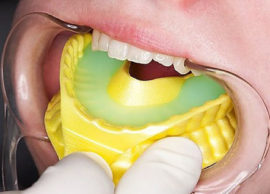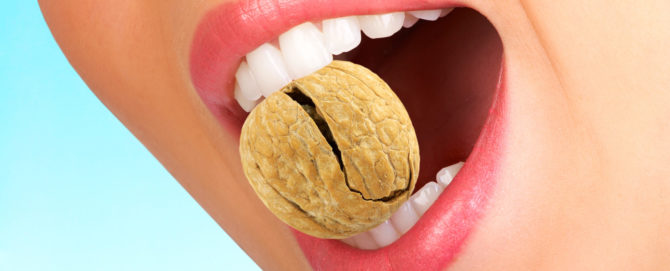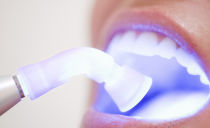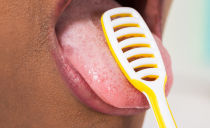How to strengthen tooth enamel at home
Dental health depends on the state of their surface protective shell. It can be subtle both due to heredity and due to the influence of pathological factors. In both cases, the tooth enamel can be strengthened by resorting to modern dental methods or by using effective folk remedies.
Content
What does tooth enamel consist of and why is it thinning
Enamel protects dentin and pulp from injuries and the negative effects of the bacterial microflora that lives in the oral cavity, and is the thinnest, but the strongest layer of the tooth. The basis of its composition is minerals (about 95%), a large proportion of which are calcium and phosphorus. With age, the ratio of organic and inorganic substances changes, and the enamel becomes thinner, weaker and more susceptible to caries.
The rate of destruction of the surface layer of teeth depends on factors related to both heredity and lifestyle, hygiene and nutrition. Often the reason that it begins to collapse is the wrong brushing technique or an incorrectly selected toothbrush.
Most often, fine tooth enamel is observed in smokers. This is due to cigarette smoke containing resins and other harmful impurities deposited on the tooth surface.
The hard tissues that make up a person’s teeth are not able to regenerate, therefore external assistance is required to strengthen and restore them. Tooth enamel can be strengthened by passing special dental procedures, during which it is saturated with fluorine and calcium. And also with the help of folk remedies and through the constant use of specialized toothpaste.
In addition, you should protect yourself from negative factors that enhance destructive processes. Food and drinks that inhibit the beneficial microflora of the oral cavity are harmful to enamel:
- Carbonated drinks.
- Sweets.
- Alcohol
- Seeds and nuts.
- Acidic products, for example, citrus juices.
The harm of citrus juices can be minimized by using a drinking straw to reduce the area of contact of the acid with the surface of the teeth.
How to understand that the enamel began to collapse
 Visually determine that hard dental tissues are deficient in trace elements, it is possible only in the later stages - when visible defects appear on the surface of the teeth.
Visually determine that hard dental tissues are deficient in trace elements, it is possible only in the later stages - when visible defects appear on the surface of the teeth.
The first sign of enamel weakness is an increase in sensitivity. If you do nothing at this stage, the color of the teeth may change - they will acquire a yellowish or grayish tint and become transparent at the edges. Then, small cracks and chips will begin to appear on the tooth surface, the teeth will become brittle, some of them will be affected by caries.
How to strengthen tooth enamel at home
To strengthen the enamel at home, special strengthening pastes and gels are used, as well as folk remedies. The effectiveness of home therapy depends on how accurately the patient fulfills the instructions of the dentist. It is necessary to use only those means for strengthening tooth enamel that the doctor will approve.
Home procedures do not require special preparation, they can be done independently, following the instructions of the doctor.Mouthguards with medicinal compounds should be worn once a day, the duration of one session should not exceed 20 minutes.
With weak enamel, it is recommended to use strengthening toothpastes. In order to prevent imbalance of minerals in the hard tissues of teeth, it is necessary to alternate calcining pastes with fluorinating ones.
How to strengthen tooth enamel folk remedies
To prevent demineralization and strengthen weakened enamel, natural folk remedies are used. With their help, tooth enamel can be strengthened at home without extra costs and with the benefit of the whole body, but only in the absence of obvious signs of its destruction.
The most popular traditional medicine used to restore tooth enamel are:
- Beekeeping products. To strengthen tooth enamel at home, you can make a natural chewing gum from propolis or beeswax, honey, lemon juice and peppermint oil. The recipe for its preparation is simple: all of the listed ingredients are mixed until a homogeneous mass is obtained. This chewing gum is recommended to be used after each meal. It provides high-quality cleansing of the teeth and saturation with useful trace elements.
- Salt rinses and applications. To rinse the oral cavity with weak saline should be 2 times a day, after morning and evening brushing. Gum massage with gruel from sea salt with vegetable oil is done 1-2 times a week. Due to the fact that the salt disinfects the oral cavity, the enamel is not destroyed by pathogenic microorganisms.
- Activated carbon. The activated carbon tablet must be ground into a fine powder, combined with a few drops of water and mixed until a pasty mixture is obtained. Such a composition should brush your teeth every 3-4 days. Coal neutralizes the effect of food colors and qualitatively cleans tooth enamel.
- Strawberry. A strawberry mask helps restore tooth enamel. Rub the gums and the surface of the teeth with the berry and hold the gruel in the mouth for several minutes.
Methods of strengthening tooth enamel in dentistry
When weakening tooth enamel, dentists recommend performing procedures aimed at saturating it with missing chemical elements.
Remineralization
Demineralization - a decrease in the level of calcium and phosphorus in the hard tissues of teeth - is the main reason for reducing their strength and increasing sensitivity to chemical and thermal stimuli. The essence of remineralization is to saturate the surface layer of teeth with phosphorus and calcium. A special composition containing these trace elements is applied to the surface of the teeth by application or using cap.
 With what composition to strengthen the enamel and how long to carry out the procedure, the doctor decides on the basis of the condition of the enamel and the age of the patient. The procedure is even used to strengthen children's teeth and restore the tooth surface during or after orthodontic treatment. Remineralization can be prescribed from the age of six.
With what composition to strengthen the enamel and how long to carry out the procedure, the doctor decides on the basis of the condition of the enamel and the age of the patient. The procedure is even used to strengthen children's teeth and restore the tooth surface during or after orthodontic treatment. Remineralization can be prescribed from the age of six.
After rehabilitation therapy, the risk of developing caries, the intensity of the manifestation of fluorosis, hyperesthesia (sensitivity) are reduced, and the microflora of the oral cavity is normalized. An additional advantage of the procedure is the clarification of tooth enamel to 5 tones.
Fluoridation
In addition to calcium and phosphorus, fluorine is part of hard dental tissues. The level of its concentration affects the strength of enamel and its ability to absorb calcium.
Deep fluoridation is carried out by the dentist no more than once a year with the help of special preparations for professional use, penetrating deep into the dental tubules. To strengthen tooth enamel at home, gentle compounds that act only on the surface are used. Such procedures can be done monthly.





